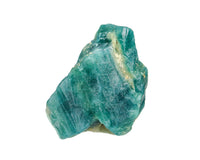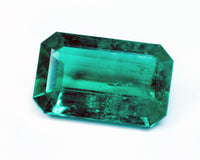- 1. Chrysocolla
- 2. The History and Meaning of Chrysocolla
- 3. Physico-Chemical Properties of Chrysocolla
- 4. Types and Colors of Chrysocolla
- 5. Chrysocolla Healing Properties
- 6. Chrysocolla Metaphysical Properties
- 7. Chrysocolla For Sale
Chrysocolla
If you are new to stone collecting or jewelry making, the name chrysocolla is unlikely to tell you much. This, however, does not mean that the stone should be deprived of praise. Its malachite-like appearance and pretty turquoise patterns won't leave you uninspired.

The History and Meaning of Chrysocolla
The gem of mesmerizing turquoise color is known since antiquity. The ancient Greek philosopher Theophrastus gave it its name and description in the 4th century BC. The name ‘chrysocolla’ is comprised of two ancient Greek words: χρυσός meaning ‘gold’ and κόλλα standing for ‘gum’ or ‘glue’. Thus, chrysocolla can be translated as glue for gold. It turns out that back then, these stones were used as solder for crafting gold jewelry. You can also come across various alternative monikers of the mineral - mountain green, copper malachite, or copper green.
In ancient Egypt and Israel, chrysocolla became raw material for copper smelting. Along with that, ground stones were used as blue paint for dishes, paintings, and frescoes. Egyptian women (and some men as well) utilized chrysocolla powder as eye shadows. Besides decorative qualities, this powder was believed to rejuvenate and protect eyesight.
The Israeli kingdom of King Solomon owes its might and prosperity to chrysocolla. The legendary mines of Solomon made him immensely rich. However, many scholars believe that these mines delivered not gold but copper. Archaeologists even found giant depleted copper mines on the Sinai Peninsula. They came to the conclusion that it had been the copper trade that made Solomon one of the most affluent men of his time. And since chrysocolla is found in conjunction with copper, the ruler had unlimited access to the stone as well. The ancient name of chrysocolla, the Elat (Eilat) stone, refers to the Elat (Eilat) Gulf in the Red Sea. This mineral was also highly regarded by other rulers - they say that the emperor Nero, as well as Cleopatra herself, wore chrysocolla in their jewelry and made use of its magical properties.

Physico-Chemical Properties of Chrysocolla
From a chemical point of view, chrysocolla is a hydrous silicate of copper and aluminum. In fact, it is not a mineral per se, it is a hardened silica gel. Chrysocolla is often fused with other minerals such as chalcedony, turquoise, malachite, or quartz, which give it beautiful colors and intricate patterns but, at the same time, make it difficult to cut and use as a gemstone.
Chrysocolla is found in fields where copper ores occur. The blend of water, silicic acid, and oxidized cuprite form the mineral. In its chemical compositing, it contains 16-75% of copper, up to 30% of water, and 10-65% of silicic acid.
Chrysocolla is a fairly light and soft mineral with a hardness of 2 to 4 on the Mohs scale. In addition, it is very fragile, sensitive to acids and household chemicals, as well as cleaning products. For this reason, you should not pick chrysocolla for rings and everyday jewelry - there is a high chance of splitting or damaging an inlay.
Specimens of chrysocolla are predominately opaque although due to inclusions of other minerals some areas may be translucent. Polished stones show varying types of luster – from vitreous to waxy and earthy.

Types and Colors of Chrysocolla
Chrysocolla provides a range of turquoise colors - sky blue, light blue, teal, cyan, green-blue, etc. Some specimens may carry brown and black hues but they are less common. The predominance of certain chemical elements in the composition has a direct impact on the color. Copper content gives the mineral a turquoise tint while the inclusions of manganese color it brown. Green shades in specimens are the result of blending such elements as iron, copper, and aluminum.
Based on the origin, chemical composition, and properties, chrysocolla is available in the following varieties:
• Asperolite is a type of chrysocolla with the highest proportion of water in its composition. These brittle crystals occur in the shape of a kidney and have greenish-blue hues.
• Bispite is a blue mineral featuring low water content. It is harder and h2er than asperolite.
• Demidovite is a blue or greenish variety that grows on malachite formations. This stone, which was first found in the Urals Mountains, is used in jewelry and crafts due to its similarity with turquoise, it is the most valuable among all types of chrysocolla. Its chemical composition is rich in phosphorus.
• Stellarite is a blue gemstone composed of chrysocolla and quartz. Sometimes, it is simply called chrysocolla quartz.
• Parrot wing is a blend of chrysocolla and jasper known for its greenish-brown color.
• Precious silica (sometimes referred to as chrysocolla chalcedony) is a rare and valuable mineral. It does not belong to the chrysocolla family but it has a similar color thanks to the admixture of copper.
Besides that, chrysocolla is distinguished by the place of mining. The most valuable specimens are Arizonian, Mexican, Peruvian, and Congolese.

Chrysocolla Healing Properties
The mineral is highly esteemed for its beneficial effect on the female body. It restores the functioning of the genital organs, eases menstrual pain and inflammation, improves ovarian function, and normalizes hormonal levels. Aside from that, it positively affects pregnant women as well as women who have recently given birth by smoothing out hormonal changes in their bodies. You can use the healing properties of chrysocolla to cure infertility in females and males alike.
The mineral is also of great use in treating respiratory diseases, sore throat, bronchitis, and chronic cough. It is able to relieve asthma attacks and pain, help remove sputum, and speed up recovery. To reap these benefits, you should either apply chrysocolla plates to the chest or wear a pendant featuring mineral inlays. Chrysocolla beads or necklaces worn around the neck are capable of fighting thyroid gland diseases.
Lithotherapists recommend chrysocolla bracelets and rings to those who suffer from diseases of the digestive tract. It is believed that the mineral is able to restore the mucous membrane and cure ulcers.

Chrysocolla Metaphysical Properties
Chrysocolla is considered to be a female stone because of its ability to concentrate Yin energy. It is suitable for women of any age but its properties can manifest themselves in different ways. In girls, it awakens femininity. In young women, it enhances sexuality and maternal instinct. It gives wisdom and insight to the elderly.
Amulets made of the mineral will protect against evil spirits as well as relieve illusions and obsessive thoughts. For instance, if you constantly think about having a drink, chrysocolla may ease the craving for alcohol and eventually help combat addiction.
Besides that, chrysocolla is a stone of wisdom. It is indispensable for researchers, scientists, scholars, discoverers, etc. The stone helps sane people to easily articulate their thoughts while teaching dreamers to live in the real world instead of their illusions.
The magic of chrysocolla improves communication skills, makes a person more talkative and open, as well as aids to get rid of shyness and isolation. Along with that, the mineral has a beneficial effect on intuition as well as promotes tolerance and inner harmony.

Chrysocolla For Sale
Chrysocolla is a must-have if you enjoy gemstones of turquoise colors and intricate patterns. At KenKenGems, you’ll find an extensive selection of chrysocolla stones for your DIY jewelry efforts and collecting. We supply:
one-of-a-kind chrysocolla gems;
loose stones and sets of 2 and 3 stones of various sizes;
strands and half-strands;
pendants set in gold and silver.
Our chrysocolla gems come from the best mines in Peru, Congo, and all over the world. High standards of cutting and treatment ensure the finest quality.




